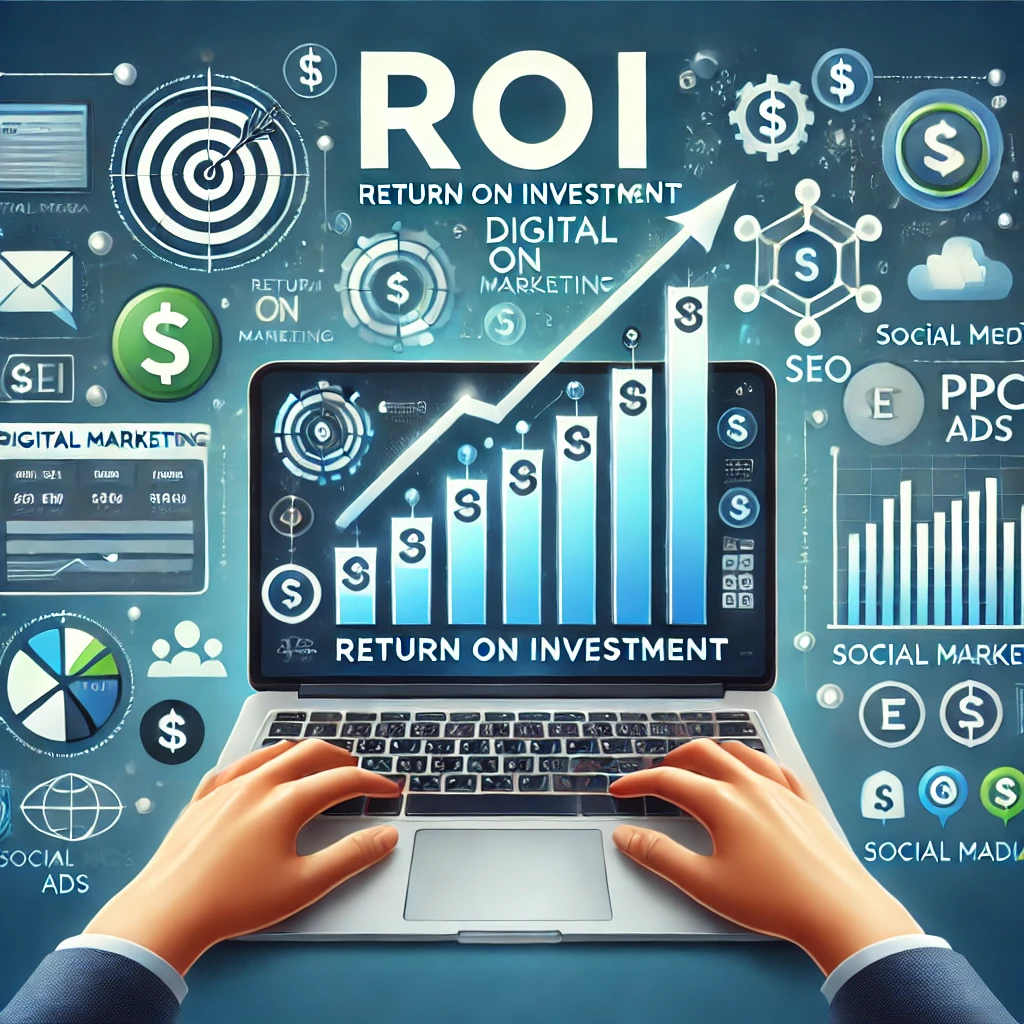
It is essential to measure your campaigns’ efficacy in the ever-changing digital marketing industry. The return on investment (ROI) is one of the most important metrics to keep track of. So, whether you’re an experienced marketer or a business owner wading into the digital landscape, understanding ROI can be the difference between success and failure in your marketing efforts. This blog will define ROI, its significance, methods to calculate ROI, and ways to enhance it. As one of the digital marketing freelancers in Thrissur, I will talk about the challenges associated with measuring ROI and the tools that can help you through this blog.
What is ROI in Digital Marketing?
The return on investment (ROI) is a performance measure used to evaluate the efficiency or profitability of an investment. In digital marketing, ROI in digital marketing compares how much you get in return from your marketing campaigns against how much you spend on them. It addresses the vital question: “Was the money I invested in this campaign worth it?”
ROI is usually shown as a percentage or ratio. Positive ROI means that your campaign brought in more revenue than it cost, whereas a negative ROI means your campaign caused a loss.
History of ROI
The concept of return on investment has been around for centuries. ROI originated in accounting and banking. Companies began to realize its importance in the early 20th century as they began to look for ways to measure the profit of their investments. With the growth of digital marketing in the late 1990s and early 2000s, ROI became the primary metric for evaluating campaigns. Compared to traditional marketing, digital marketing has more precise tracking options, making it easier to measure ROI.
ROI is a widely used metric to measure the results of marketing strategies such as social media ads and email campaigns.
Important Of ROI in Digital Marketing?
The ultimate standard of digital marketing effectiveness is the return on investment (ROI). why ROI in digital marketing is important :
Justifies Marketing Spend: ROI helps you determine the effectiveness of the advertising costs you incur. It makes sure that you do not spend your money on advertising that does not work.
Guides Decision-Making: Through ROI analysis, you can identify the most effective strategies and, therefore, allocate your resources well.
Proves Value to Stakeholders: A good ROI can be used to prove to clients, investors, or company executives the value of your marketing efforts.
Optimizes Campaigns: As you monitor the ROI, you are able to make real time changes and improvements on the campaigns to enhance results.
Sets Benchmarks: As a standard, ROI can help you set some realistic goals and expectations to use as a future attempt benchmark.
Importance of ROI in Digital Marketing

Assessing Campaign Effectiveness
Data is king in the digital era. Businesses can make decisions based on factual information rather than or guessing by measuring ROI. Thus, the risks are reduced and the chances of success are enhanced.
Budget Allocation and Decision-Making
Measuring the return on investment is useful for companies to determine which campaigns are not performing well and, therefore, to invest more in the strategies that yield the most results. Example, if an email marketing campaign has low ROI, you can try to change the subject, content or targeting to enhance the results.
Performance Tracking and Accountability
The help of ROI in digital marketing calculation, it is possible to determine which of the campaigns is effective and which one is failed, and repeat the successful one. This not only boosts profitability, but it also gives important information on future marketing decisions.
How to Calculate ROI in Digital Marketing
Calculating ROI in digital marketing is straightforward. The formula is:
ROI = [(Revenue Generated – Cost of Campaign) / Cost of Campaign] x 100
Let’s break it down with an example:
- Suppose you spent $1,000 on a Google Ads campaign.
- The campaign generated $5,000 in revenue.
Using the formula:
ROI = [(5,000−5,000−1,000) / $1,000] x 100 = 400%
How to Improve Your ROI in Digital Marketing

To make sure that your digital marketing activities provide the most returns, you must increase your Return on Investment (ROI) in digital marketing. Whether you are a Thrissur freelancer in digital marketing, a marketing expert, or a business owner, these top 5 tactics can help you maximize your efforts and increase your return on investment. This is a novel approach to raising your ROI:
- Set Clear Goals and KPIs: Set specific, quantifiable, and realistic goals for your digital marketing campaigns. No matter if it is the growth of website traffic, creation of leads or improvement of sales, it is important to have specific goals to measure progress. Conversion rates, cost per acquisition (CPA), and customer lifetime value (CLV) are KPIs that can help you monitor performance and make decisions that are backed by data.
- Target the Right Audience: Focus on the right people you want to reach with your product or service. You can use Google Analytics, Facebook Audience Insights and customer personas to determine your audience’s demographics, interests and behavior. Segment and personalize your marketing efforts to send the right message to the right people at the right time and in the right channel, so that your message will reach your target audience and will prompt them to engage with your brand.
- Optimize Campaigns with Data Analytics: It is recommended to regularly track and evaluate the effectiveness of the campaign using tools such as Google Ads, Facebook Ads Manager or any other marketing automation tools. Thus, it is possible to determine poorly performing areas and redirect your budget to the most effective channels or strategies. On top of that, A/B testing of the ad creatives, headlines, and CTAs is also good to improve your campaigns output.
- Invest in Content Marketing and SEO: High quality and valuable content not only helps to attract potential customers but also enhances your search engine rankings. Focus on creating blog posts, videos, infographics, and other content that are relevant to your audience’s pain points and interests. Together with SEO, keyword research, on-page optimization, and backlinks – all of these will help to organically drive traffic and reduce your dependence on paid ads.
- Leverage Automation and Retargeting: Marketing automation tools should be used to perform routine tasks like email marketing, social media posting, and generation to name a few. This maintains constant contact with your audience with no extra cost but with a lot of time and resources saved. Also, design retargeting campaigns to bring back users who have been in contact with your brand but did not convert. Retargeting is a good way of reminding the potential customer about your brand and probably get them to come back to your sales funnel.
What’s a Good Digital Marketing ROI?
The “Good” ROI for digital marketing depends on industry, business model and campaign goals, but in principle, a 5:1 ratio is considered strong meaning you earn 5forevery1 spent. In some companies, the 10:1 ratio is exceptional and indicates a highly effective campaign, while the 2:1 ratio is often considered the minimum standard for gaps. Nevertheless, it is important to consider the context.
For example, brand awareness campaigns can reduce the impending profitability of your investment, but can contribute to the long-term growth and loyalty of your customers. For Thrissur Digital Marketing Freelancers, achieving excellent ROI profitability not only helps demonstrate the value of your customer’s service, but also creates a reputation to achieve measurable results. Ultimately, a good ROI is one that aligns with your business goals and provides sustainable growth over time.
Conclusion
ROI in digital marketing is a way of thinking, not just a metric. Businesses and marketers can improve their tactics, make more informed judgments, and achieve long-term success by comprehending and monitoring ROI. ROI makes sure that every dollar spent helps you succeed, whether you’re operating a large-scale digital marketing campaign or a small firm.
